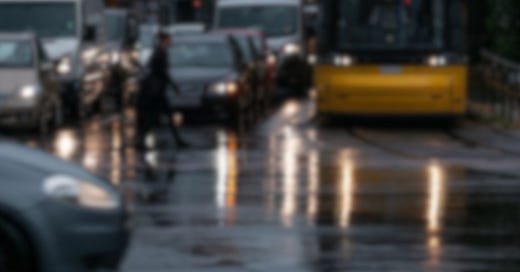I’m constantly being told that people who drive pay for the roads and bridges they use, while people who ride bikes and buses don’t. Their claim is that gas taxes and other car-related fees pay for the infrastructure. Sure, those fees pay. Just like chipping in a couple quarters towards something that costs a dollar is paying. You’re paying towards something but you’re not covering the costs.
I’ve been finding myself talking about funding a lot recently because of New York City’s recent tolling program in Manhattan’s “decongestion zone.” The $9 tolls collected from people driving themselves into the central business district are going to the Metropolitan Transportation Agency to improve public transit. It started two months ago, and has cleared $37.5 million in profit after operating expenses. Supporters are delighted because buses, trains, and subways are in desperate need of funding. Opponents are furious because people using one mode are paying part of the travel expenses of another mode.
You’d probably guess that I don’t care that people driving themselves are partially funding public transit improvements. But my feelings aside, it’s a logical approach. It’s exactly what a corporation would do if a city’s streets were privatized. It’s like when you buy a ticket to an all-inclusive resort and get access to a dessert buffet or dance classes you never use. You, the customer, find value in the vacation package and are willing to pay the fee for access to things you may or may not take advantage of. The cars-pay-for-transit approach also reminds me of restaurants. Sodas are marked up notoriously high (1000% is not unusual) in order to help subsidize other menu items that have a slim profit margin. Selling soda can make it possible to earn a profit on shrimp tacos or homemade rolls.
A restaurant doesn’t simply manage seafood or bread or fountain drinks, it manages an entire system. A city doesn’t simply manage long-distance car commuters, it manages an entire transportation system for all ages, all abilities, and all ways of getting around. There’s no reason to treat each mode as a standalone product or service.
User fees—whether gas taxes, transit fares, vehicle registrations, or tolls—cover only a fraction of the actual costs of building, maintaining, and operating transportation infrastructure. About half, is the generous estimate by the US Department of Transportation. The remainder is subsidized by general tax revenues.
Not all transportation system users place the same burden on the network. Motor vehicles have the greatest impact due to their size and weight. Even when operated safely, the wear and tear on infrastructure is undeniable. The physical space required for vehicles—both moving and stationary—limits a city’s ability to accommodate other forms of transportation.
So if I was running a city transportation system, of course I would charge a premium for trucks and single-occupant vehicles and use those fees to expand the transit and bike networks. Not for some feel good social or environmental reason, but because it would make good business sense. For some people, it’s worth paying a steep fee to drive themselves. For others, the personal finance calculation will nudge them to opt out of driving.
Investments in transit, biking, and walking infrastructure are good for the overall system. A study by the Victoria Transport Policy Institute found that shifting just 5% of urban trips from cars to active transportation modes significantly decreases congestion and road maintenance expenses. And wouldn’t you know it, New York’s tolling program reduced car trips by 7% in lower Manhattan.
In today’s standard model of publicly managed transportation, don't get hung up on whether roads, transit, bike lanes, or sidewalks “pay for themselves.” None of them do. A well-functioning transportation system is one where pricing reflects impact. Whether managed by a public agency or a private operator, the fundamental principle remains the same: the biggest users should contribute the most. That’s systems thinking.
If you’re active on a social media platform, here’s an experiment. When someone throws out the predictable "mass transit is heavily subsidized," ask questions like:
Should the government subsidize any transportation systems at all? If so, what type, why, and how?
Should taxpayers fund taxpayer transportation services like shared buses and bikes? Why or why not?
Should taxpayers be forced to fund private travel expenses (personal cars) even if the taxpayers don't use private transportation themselves? Why or why not?
What metrics should be used to determine if subsidized infrastructure is working? And how do you define "working"?
If public transportation was prioritized over private personal car travel, would taxpayers benefit? Why or why not? ("Public" meaning any type of fleets that could be shared, including buses, trains, subways, bikes and e-bikes.)
What percentage of American car infrastructure is subsidized by general tax money regardless of how much the taxpayers use the roads?
Why does the current American infrastructure funding model promote and preserve car dependency rather than mobility freedom? Who stands to benefit the most from Americans being dependent on personal cars?
Have you ever been to an all-inclusive resort?





For congestion pricing, what are your thoughts on adding more nuances, such as: 1) doing it by vehicle wright, to nudge people to have smaller cars and business to have smaller trucks, and 2) having fees be higher at peak hours (7 am to 7 pm), to shift some driving to non-peak times.
picture shows a tram in Berlin, the city where I designed passenger information after 1990 and made all buses, trams and trains yellow